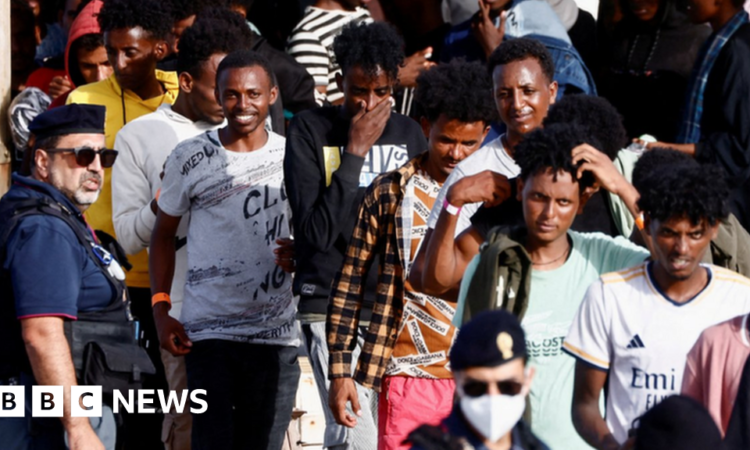
- By Reha Kansara & Emir Nader
- BBC Trending & Newsnight, in Lampedusa
Thousands of migrants arrived on the shores of Lampedusa last week, overloading local resources on the Italian island. The BBC’s Reha Kansara and Emir Nader visited the holding centre, also known as the “Hotspot”, where migrants are held.
Lampedusa’s Hotspot has seen busier days.
A day before, rows of migrants – mostly men from sub-Saharan Africa and the Middle East – sought shade under a sprinkling of trees by the iron-gated entrance to the camp.
Now, as we walk into it, those areas are deserted, with no evidence of overcrowding left behind.
In recent months, the centre has been overwhelmed beyond its capacity. The Italian Red Cross estimates the island hosted at least 10,000 newly arrived people last week, many of them coming by boat from Tunisia.
Local residents handed out food, water and clothing as migrants struggled to find space inside the centre, which was built for just 400 people.
For a centre that has been thrust into the international spotlight, the Hotspot is surprisingly small – just 200 metres long.
As we walked along the strip that makes up this camp, a group of men danced to popular West African and Arabic music. We tried to speak to some of the migrants but, each time, the Red Cross blocked us, saying we needed further permission to do so from government authorities.
We only see four women, resting on a makeshift bed, but many of the boys appear to be in their early teens.
The previous day we spoke to Ahmed, a 20-year-old from Egypt, through the holding centre’s gate.
He said he took a three-day boat journey from Libya to arrive here. As we were speaking two soldiers interrupted and Ahmed was quick to reassure them that he was saying he’s being well provided for.
He said the other migrants were scared to speak to the media.
Ignazio Schintu, from the Italian Red Cross, says having so many people in such a tight space, with few health services and little logistics, can “blow up the whole reception and relief machine”.
Many of these migrants have now been transferred by ferry to one of four processing centres in Sicily and mainland Italy.
After last week’s surge, Italian prime minister Giorgia Meloni visited the island with the President of the EU Commission, Ursula von der Leyen. In an announcement that was firm in language but light on detail, Ms Meloni’s government called the arrivals an “invasion” and an “act of war”.
But the island’s mayor, Filippo Mannino, says otherwise.
“The island has been living with this phenomenon for 30 years now, but to outsiders there is a perception that there’s complete chaos here: ‘Island in collapse’, ‘Island under attack’. This is not the case,” he says.
Meanwhile, the EU is preparing to transfer €1bn (£872m) to nearby autocratic Tunisia to bolster its economy and stop boats leaving.
But there are cracks in European co-operation. The French government has since said it will refuse to take arrivals from Lampedusa.
Pulled between international forces so much greater than its size, what happens in Lampedusa will be determined by power brokers elsewhere.
This doesn’t feel like an island in crisis, or one doomed to it. Its people don’t use the hostile rhetoric of Italy’s political leaders.
But they petition to confront the challenge, to find humane solutions so that locals who would offer sea-farers protection aren’t cast adrift.
“I’m not the one who can decide a solution because I’m just the mayor of a small island,” says Mr Mannino.
“But we have to choose whether to treat people all the same or not, whether they are Ukrainians fleeing war, or Africans fleeing war and persecution. Do we treat them all the same or do we treat them according to the colour of their skin?”






